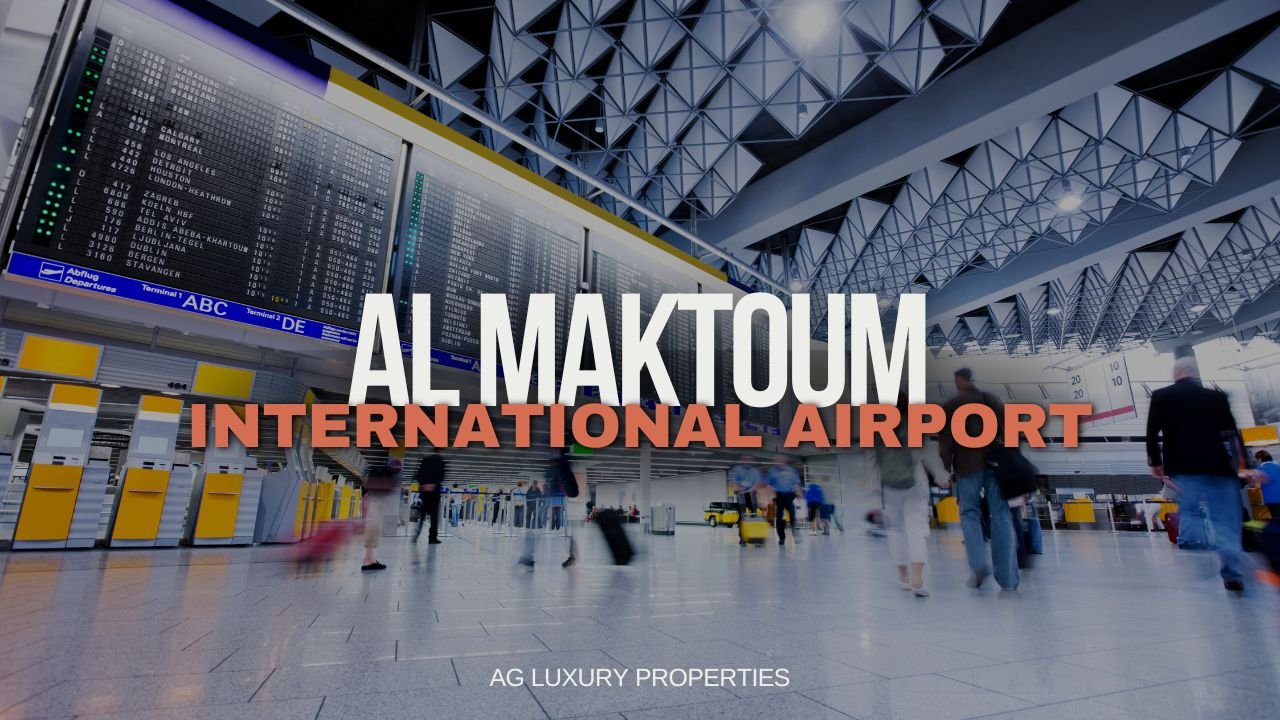Dubai’s aviation landscape has undergone a remarkable transformation over the past few decades, with Al Maktoum International Airport standing as a testament to the emirate’s ambitious vision for the future. This state-of-the-art facility represents more than just another airport; it embodies Dubai’s commitment to becoming the world’s leading aviation hub and significantly impacts the region’s economic growth, particularly in the Dubai Luxury Real Estate sector.
Understanding Al Maktoum International Airport
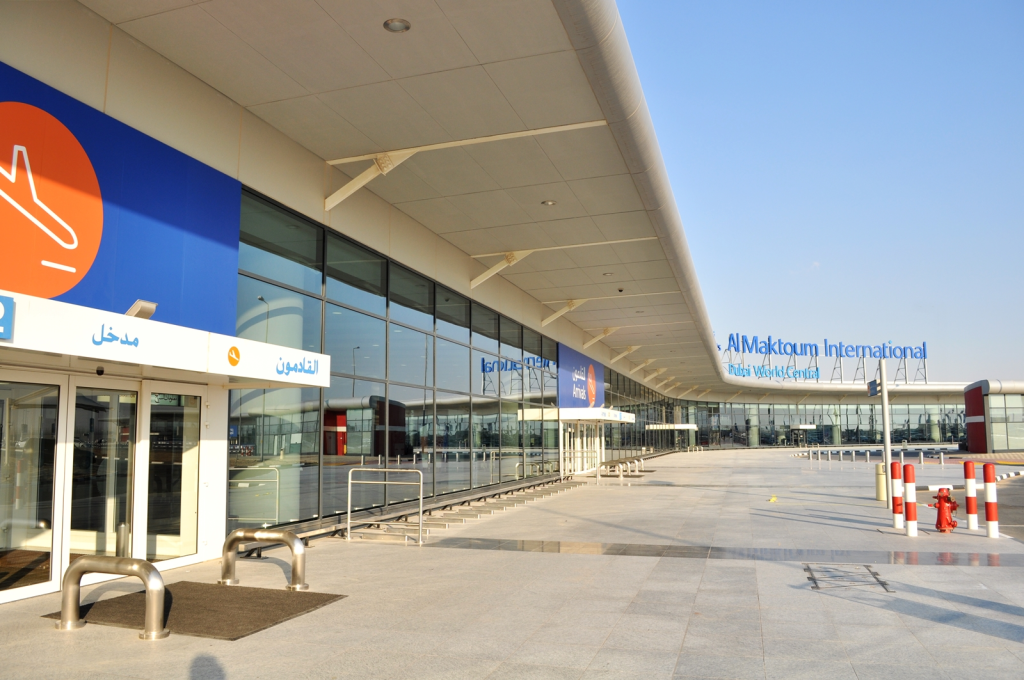
Al Maktoum International Airport, also known by its IATA code DWC (Dubai World Central), is Dubai’s second major airport facility located in the Dubai South district. Named after the ruling Al Maktoum family, this airport has been designed to complement and eventually surpass Dubai International Airport (DXB) in terms of capacity and operational efficiency.
Key Statistics
| Metric | Current Status | Future Projections |
|---|---|---|
| Total Land Area | 140 sq km | 140 sq km (fully utilized) |
| Passenger Capacity | 5 million annually | 220 million annually |
| Cargo Capacity | 12 million tons | 12+ million tons |
| Runways | 1 (4,500m) | 5 planned runways |
| Investment to Date | $32 billion USD | $82 billion USD (total planned) |
| Direct Jobs Created | 15,000+ | 750,000+ (when fully operational) |
| Airlines Operating | 12+ carriers | 100+ carriers (projected) |
The airport opened its doors to commercial operations in October 2013, marking a significant milestone in Dubai’s aviation history. Initially serving cargo operations and limited passenger services, Al Maktoum International Airport has gradually expanded its role in Dubai’s transportation ecosystem. The facility is strategically positioned to serve as the cornerstone of Dubai World Central, a massive aerotropolis development that spans over 140 square kilometers.
Where is Al Maktoum International Airport Located?

Where is Al Maktoum International Airport situated exactly? The airport is strategically located in the Dubai South area, approximately 37 kilometers southwest of Dubai’s city center. This prime location places it at the heart of the Dubai World Central development, which has been designed as a comprehensive logistics and business hub.
The airport’s location offers several advantages for both passengers and cargo operations. Its proximity to major highways, including Sheikh Mohammed Bin Zayed Road and Al Maktoum International Airport Road, ensures excellent connectivity to various parts of the UAE. The location also provides ample space for future expansion, addressing the capacity constraints that Dubai International Airport faces due to its urban setting.
From a geographical perspective, Al Maktoum International Airport sits at coordinates 24.8967° N, 55.1613° E, positioning it ideally to serve as a connecting hub between Asia, Europe, and Africa. This strategic location makes it an attractive option for airlines looking to establish or expand their Middle Eastern operations.
The Development Timeline and Opening Status
One of the most frequently asked questions is “When will Al Maktoum International Airport open” to full operations. While the airport has been operational since 2013, its development has been planned in multiple phases. The first phase, which included the passenger terminal and initial runway, began commercial operations with limited services.
Development Phases and Investment Timeline
| Phase | Timeline | Investment | Key Developments | Capacity Added |
|---|---|---|---|---|
| Phase 1 | 2010-2013 | $4.5 billion | First runway, basic terminal, cargo facilities | 5M passengers, 1.2M tons cargo |
| Phase 2 | 2014-2020 | $8.2 billion | Terminal expansion, enhanced cargo | 15M passengers, 3.5M tons cargo |
| Phase 3 | 2020-2027 | $15.6 billion | Additional runways, new terminals | 50M passengers, 7.2M tons cargo |
| Phase 4 | 2027-2032 | $25.8 billion | Major terminal complex, full cargo hub | 120M passengers, 12M tons cargo |
| Final Phase | 2032-2040 | $28.0 billion | Complete aerotropolis integration | 220M passengers, 12M+ tons cargo |
- Phase 1 (2010-2013): The initial construction phase focused on building the basic infrastructure, including the first runway, cargo facilities, and a modest passenger terminal capable of handling 5 million passengers annually.
- Phase 2 (2014-2020): This phase involved expanding cargo operations and enhancing the passenger terminal facilities. During this period, the airport primarily served low-cost carriers and cargo operations.
- Current Phase (2020-2027): The ongoing development includes significant expansion of passenger facilities, addition of new runways, and enhancement of cargo capabilities. The COVID-19 pandemic has influenced the timeline, with some developments being accelerated to meet changing aviation demands.
- Future Phases (2027 onwards): Long-term plans include the development of additional terminals, expansion to handle up to 220 million passengers annually, and the complete integration with the Dubai World Central aerotropolis.
Airport Infrastructure and Facilities

Al Maktoum International Airport boasts impressive infrastructure designed to handle both current needs and future growth. The airport currently features a single passenger terminal spread across 125,000 square meters, capable of processing millions of passengers annually with room for significant expansion.
Current Infrastructure Specifications
| Infrastructure Component | Current Capacity | Size/Specifications | Planned Expansion |
|---|---|---|---|
| Passenger Terminal | 5M passengers/year | 125,000 sq meters | 1.2M sq meters |
| Cargo Terminals | 12M tons/year | 485,000 sq meters | 2.8M sq meters |
| Runways | 1 active runway | 4,500m x 60m | 5 total runways |
| Aircraft Parking Stands | 64 stands | Mix of wide/narrow body | 400+ stands |
| Cargo Aircraft Stands | 16 dedicated stands | Freighter optimized | 85+ cargo stands |
| Air Traffic Control | 45 movements/hour | State-of-the-art systems | 180 movements/hour |
Technology Integration Statistics
| Technology System | Implementation Level | Efficiency Gain | Cost Savings |
|---|---|---|---|
| Automated Baggage Handling | 85% automated | +35% processing speed | $2.4M annually |
| Biometric Passenger Processing | 60% coverage | +40% faster check-in | $1.8M annually |
| IoT Sensor Network | 2,400 sensors deployed | +25% operational efficiency | $3.2M annually |
| AI-Powered Resource Management | 75% implementation | +30% resource optimization | $4.1M annually |
| Digital Twin Technology | Pilot phase | +20% predictive maintenance | $1.5M annually |
The cargo facilities at Al Maktoum International Airport are particularly noteworthy, featuring multiple cargo terminals with advanced handling systems. These facilities have been designed to accommodate the growing demand for e-commerce logistics and international trade, positioning Dubai as a global cargo hub.
The airport’s runway system includes one of the longest runways in the region, measuring 4,500 meters in length. This extended runway capability allows the airport to handle the largest aircraft in commercial operation, including the Airbus A380 and Boeing 747-8F cargo variants.
Sustainability and Environmental Performance
| Environmental Metric | Current Performance | Industry Average | 2030 Target |
|---|---|---|---|
| Carbon Emissions (tons CO2/year) | 45,200 | 62,800 | 28,500 |
| Energy Efficiency Rating | 4.2/5 | 3.1/5 | 4.8/5 |
| Water Conservation (%) | 35% reduction | 18% reduction | 50% reduction |
| Waste Recycling Rate (%) | 72% | 45% | 85% |
| Renewable Energy Usage (%) | 28% | 15% | 65% |
Ground transportation facilities include dedicated areas for taxis, private vehicles, and future integration with Dubai’s public transportation network. The airport has been designed with sustainability in mind, incorporating energy-efficient systems and environmentally conscious design elements throughout the facility.
What Airlines Fly from Al Maktoum Airport?
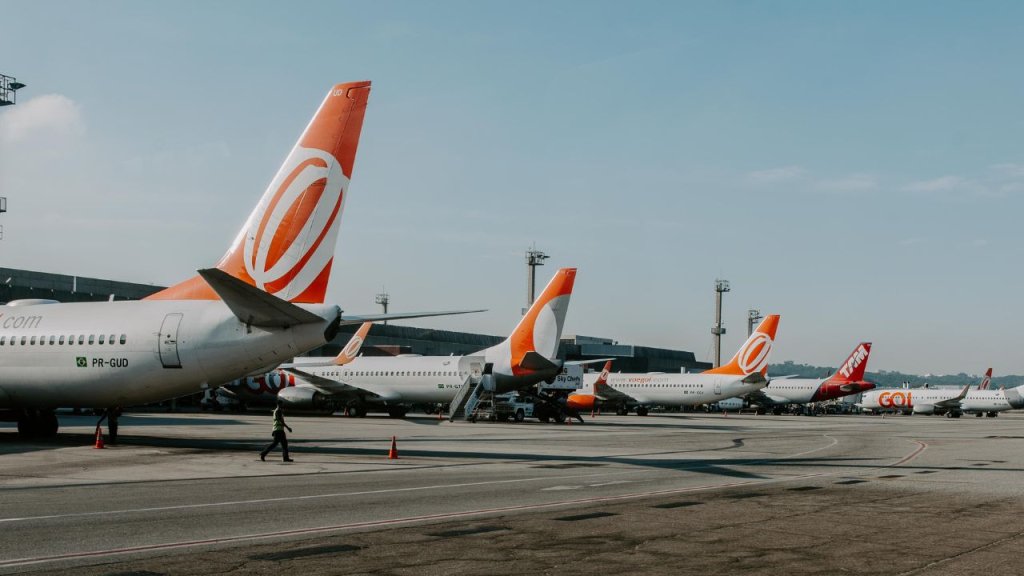
What airlines fly from Maktoum airport is a common question among travelers. Currently, Al Maktoum International Airport serves a mix of low-cost carriers, cargo airlines, and charter services. The airport has positioned itself as an attractive alternative for budget-conscious travelers and cargo operations.
Current Airline Operations (2025 Data)
| Airline Category | Airlines | Destinations | Weekly Flights | Annual Passengers |
|---|---|---|---|---|
| Low-Cost Carriers | Wizz Air, SpiceJet, Flydubai | 25+ European/Asian cities | 180+ | 2.8 million |
| Cargo Airlines | Emirates SkyCargo, DHL, FedEx, Cargolux | 45+ global destinations | 350+ | N/A (cargo only) |
| Charter/Seasonal | Various operators | 15+ seasonal routes | 45+ | 0.4 million |
| Regional Carriers | Air Arabia, flynas | 12+ Middle East destinations | 85+ | 0.8 million |
Passenger Traffic Growth Statistics
| Year | Annual Passengers | Growth Rate | Cargo Volume (tons) | Aircraft Movements |
|---|---|---|---|---|
| 2013 | 0.05 million | Launch year | 245,000 | 3,200 |
| 2015 | 0.8 million | 1,500% | 580,000 | 8,500 |
| 2017 | 1.2 million | 50% | 920,000 | 12,400 |
| 2019 | 1.8 million | 50% | 1,450,000 | 18,200 |
| 2021 | 0.9 million | -50% (COVID) | 1,680,000 | 15,800 |
| 2023 | 2.4 million | 167% | 2,100,000 | 22,500 |
| 2025 | 4.2 million | 75% | 2,850,000 | 28,900 |
Major passenger airlines operating from Al Maktoum International Airport include Wizz Air, which has established a significant presence with routes to various European and Asian destinations. The airport also serves several regional carriers and charter airlines that provide connections to destinations across the Middle East, Asia, and Europe.
Cargo operations represent a significant portion of the airport’s current activity. Major cargo carriers including Emirates SkyCargo, DHL, FedEx, and various freight airlines utilize the airport’s advanced cargo facilities for their regional and international operations.
The airport management has been actively working to attract additional airlines, offering competitive rates and modern facilities to encourage new route development. As the facility continues to expand, more airlines are expected to establish operations, particularly those focused on connecting secondary cities and emerging markets.
Al Maktoum International Airport vs Dubai International Airport
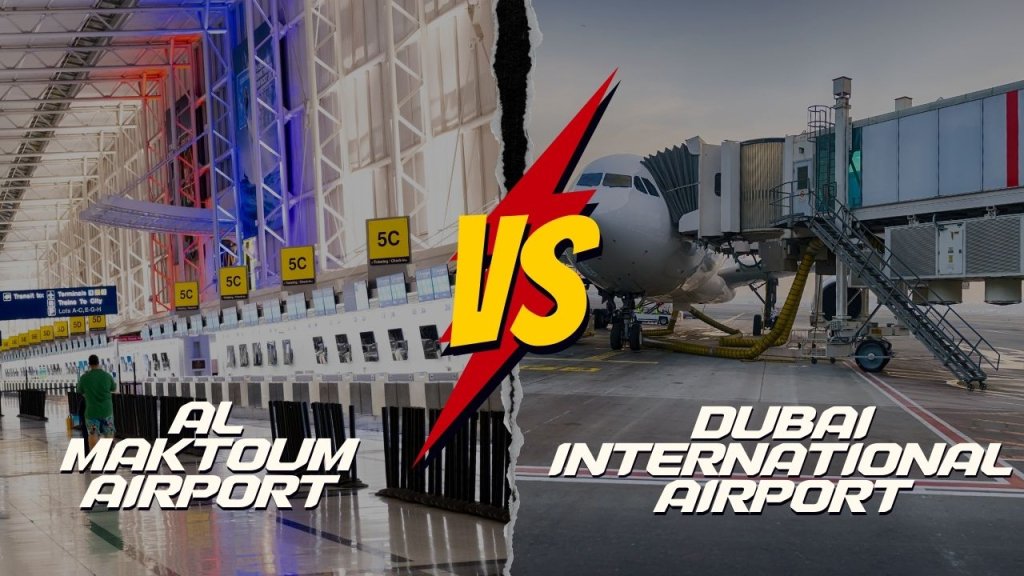
Understanding what is the difference between DWC and DXB is crucial for travelers and industry observers. While both airports serve Dubai, they have distinct characteristics and target different market segments.
| Feature | Al Maktoum International (DWC) | Dubai International (DXB) |
|---|---|---|
| Opening Year | 2013 | 1960 |
| Location | Dubai South (37km from city center) | Near city center |
| Current Capacity | 5 million passengers annually | 90 million passengers annually |
| Future Capacity | 220 million passengers (planned) | Limited expansion potential |
| Terminals | 1 terminal | 3 terminals |
| Runways | 1 runway (4,500m) | 2 runways (4,000m each) |
| Primary Focus | Low-cost carriers, cargo | Full-service carriers, premium services |
| Expansion Potential | Unlimited (140 sq km available) | Limited (urban constraints) |
| Airlines | Budget airlines, cargo carriers | Emirates, international carriers |
| Passenger Demographics | Price-conscious travelers | Business and premium travelers |
| Cargo Facilities | State-of-the-art cargo hub | Limited cargo capacity |
| Ground Transportation | Developing connectivity | Extensive metro and road connections |
| Duty-Free Shopping | Limited retail options | Extensive shopping facilities |
| Lounges | Basic facilities | Premium lounges and amenities |
This comparison highlights how the two airports complement each other in serving Dubai’s aviation needs. While DXB focuses on premium services and established routes, DWC targets growth markets and cost-effective operations.
Which is the Largest Airport in the UAE?

Which is the largest airport in the UAE depends on how one measures “largest.” Currently, Dubai International Airport (DXB) handles the highest passenger volume and has the most extensive terminal facilities. However, in terms of physical size and future potential, Al Maktoum International Airport claims the distinction.
Al Maktoum International Airport sits on a massive 140 square kilometer site, making it one of the largest airport developments in the world by land area. This vast space allows for virtually unlimited expansion possibilities, addressing one of the major constraints facing Dubai International Airport.
When fully developed, Al Maktoum International Airport is planned to become the world’s largest airport by passenger capacity, designed to handle up to 220 million passengers annually across multiple terminals. This would make it significantly larger than any current airport facility globally.
The airport’s cargo facilities are also designed to be among the world’s largest, with the potential to handle millions of tons of cargo annually. This positions the facility to play a crucial role in global logistics and supply chain operations.
Dubai’s Two-Airport Strategy
Does Dubai have two airports? The answer is definitively yes, and this dual-airport strategy represents a carefully planned approach to managing the emirate’s growing aviation demands. Dubai International Airport and Al Maktoum International Airport serve complementary roles in the city’s transportation infrastructure.
This two-airport system allows Dubai to segment its aviation market effectively. Dubai International Airport continues to serve as the premium hub for full-service carriers, business travelers, and established international routes. Meanwhile, Al Maktoum International Airport focuses on emerging markets, low-cost carriers, and cargo operations.
The dual-airport strategy also provides operational resilience. In case of capacity constraints, weather issues, or maintenance requirements at one airport, operations can be shifted or supplemented by the other facility. This redundancy is crucial for maintaining Dubai’s position as a global aviation hub.
Long-term planning suggests that as Al Maktoum International Airport reaches full development, it may eventually become Dubai’s primary passenger airport, with Dubai International Airport potentially transitioning to specialized roles or mixed-use development.
Current Usage and Operational Focus
What is Al Maktoum airport used for encompasses several key functions that have evolved since its opening. Initially conceived primarily as a cargo hub, the airport has expanded its role to include significant passenger operations while maintaining its cargo focus.
Cargo operations remain a cornerstone of the airport’s activities. The facility serves as a major hub for e-commerce logistics, international freight, and regional distribution. Advanced cargo handling systems and temperature-controlled facilities make it particularly suitable for pharmaceuticals, perishables, and high-value goods.
Passenger services have grown steadily, with the airport attracting low-cost carriers and charter airlines. The facility’s competitive pricing and modern amenities make it an attractive option for budget-conscious travelers and airlines looking to establish cost-effective operations in the region.
The airport also serves specialized aviation needs, including private jet operations, aircraft maintenance services, and aviation training facilities. These diverse functions contribute to the broader Dubai World Central ecosystem and support the emirate’s position as a global aviation center.
Impact on Dubai Real Estate Market
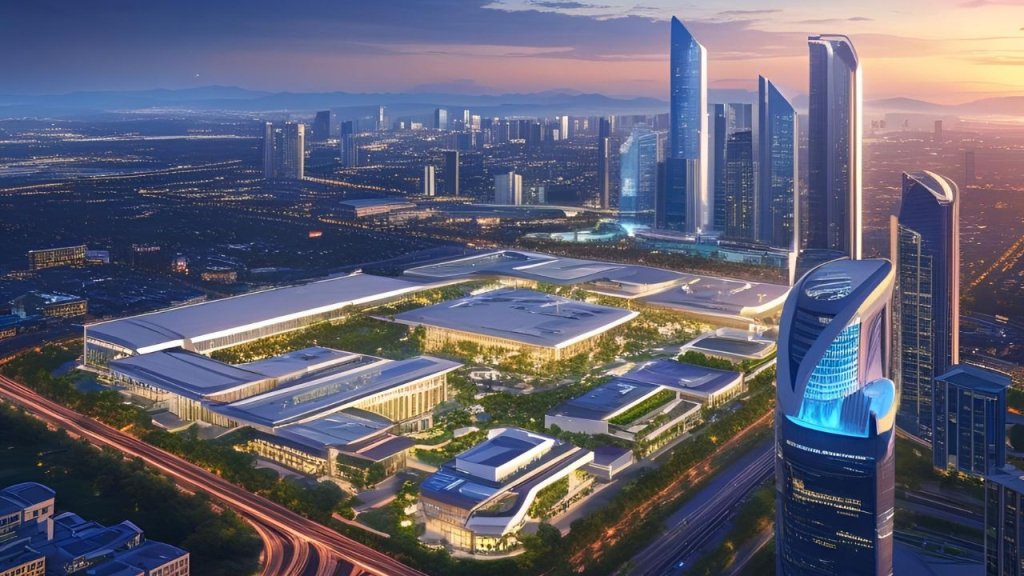
The development of Al Maktoum International Airport has had profound effects on Dubai’s real estate landscape, creating new opportunities and reshaping property values across the southern regions of the emirate. The airport’s presence has catalyzed significant residential, commercial, and industrial development in the surrounding areas.
Real Estate Market Performance Data
| Area | 2013 Average Price (AED/sq ft) | 2025 Average Price (AED/sq ft) | Price Appreciation | Rental Yield |
|---|---|---|---|---|
| Dubai South | 485 | 1,250 | +158% | 8.5% |
| Al Furjan | 650 | 1,480 | +128% | 7.2% |
| Dubai Investment Park | 520 | 1,180 | +127% | 7.8% |
| Dubai World Central | 420 | 1,320 | +214% | 9.1% |
| Arjan | 580 | 1,350 | +133% | 7.5% |
Property Development Statistics (Airport Impact Zone)
| Development Type | Units Completed (2013-2025) | Current Inventory | Under Construction | Planned Projects |
|---|---|---|---|---|
| Residential Apartments | 28,500 | 45,200 | 18,700 | 35,800 |
| Residential Villas | 8,200 | 12,400 | 4,600 | 9,200 |
| Commercial Offices | 2.4M sq ft | 4.8M sq ft | 2.1M sq ft | 6.5M sq ft |
| Retail Space | 850K sq ft | 1.6M sq ft | 580K sq ft | 1.2M sq ft |
| Industrial/Logistics | 12.5M sq ft | 18.2M sq ft | 8.9M sq ft | 22.1M sq ft |
| Hotels (Rooms) | 4,200 | 7,800 | 2,900 | 8,500 |
Employment Impact and Salary Ranges
| Job Category | Current Employment | Average Salary Range (AED) | Projected 2030 Employment |
|---|---|---|---|
| Aviation Operations | 8,500 | 60,000 – 180,000 | 45,000 |
| Logistics & Cargo | 12,200 | 45,000 – 120,000 | 65,000 |
| Hospitality | 6,800 | 35,000 – 85,000 | 38,000 |
| Retail & Services | 4,300 | 30,000 – 75,000 | 28,000 |
| Construction | 15,600 | 35,000 – 95,000 | 25,000 |
| Professional Services | 3,200 | 80,000 – 250,000 | 18,000 |
Residential Development Impact
The airport has spurred the development of numerous residential projects in Dubai South and surrounding communities. Master-planned developments like Dubai South City, Al Furjan, and Dubai Investment Park have experienced increased demand due to their proximity to the airport. Property values in these areas have shown consistent growth, with many investors recognizing the long-term potential of airport-adjacent locations.
The influx of aviation industry professionals, logistics workers, and service sector employees has created sustained demand for residential properties across various price points. From affordable housing for airport workers to luxury villas for executives, the real estate market has adapted to serve the diverse workforce that the airport attracts.
Commercial Real Estate Transformation
Al Maktoum International Airport has become a catalyst for commercial real estate development in the region. The Dubai World Central development includes extensive commercial zones, office complexes, and retail facilities designed to serve both airport users and the broader community.
Logistics and warehousing facilities have experienced particularly strong demand, with companies seeking proximity to the airport’s cargo operations. This has led to the development of specialized industrial parks and distribution centers that serve both local and international markets.
Hotels and hospitality facilities have also expanded in response to transit passengers and business travelers using the airport. Several international hotel chains have established properties in the area, recognizing the growing demand for accommodation near the airport.
Long-term Real Estate Implications
The planned expansion of Al Maktoum International Airport to handle 220 million passengers annually represents one of the most significant long-term drivers for real estate development in Dubai. This massive scale of operations will require extensive supporting infrastructure, housing, and commercial facilities.
Urban planners anticipate that the airport will eventually anchor one of the world’s largest aerotropolis developments, creating a city-within-a-city that combines residential, commercial, industrial, and recreational facilities. This vision positions the surrounding real estate as some of the most promising long-term investment opportunities in Dubai.
For those interested in exploring investment opportunities or travel arrangements, consulting with the top 10 travel agencies in Dubai can provide valuable insights into both travel planning and real estate investment potential in airport-adjacent areas.
Economic Impact and Future Prospects
Al Maktoum International Airport represents more than just transportation infrastructure; it serves as an economic engine for Dubai and the broader UAE. The airport’s development has created thousands of direct and indirect jobs while attracting international businesses to establish regional headquarters and operations centers.
Economic Impact Analysis
| Economic Indicator | Current Impact (2025) | Projected Impact (2030) | Full Capacity Impact (2040) |
|---|---|---|---|
| GDP Contribution | $8.2 billion | $18.5 billion | $54.2 billion |
| Direct Employment | 28,500 jobs | 125,000 jobs | 385,000 jobs |
| Indirect Employment | 45,200 jobs | 195,000 jobs | 580,000 jobs |
| Tax Revenue Generated | $1.1 billion | $3.2 billion | $8.7 billion |
| International Trade Volume | $28 billion | $95 billion | $285 billion |
| Tourist Spending | $2.4 billion | $8.9 billion | $32.1 billion |
Industry Sector Growth
| Sector | Companies Established | Investment Attracted (USD) | Jobs Created |
|---|---|---|---|
| Logistics & Supply Chain | 245 companies | $4.2 billion | 18,500 |
| Aviation Services | 128 companies | $2.8 billion | 12,200 |
| Manufacturing | 89 companies | $3.1 billion | 8,900 |
| Technology & Innovation | 156 companies | $1.9 billion | 6,400 |
| Tourism & Hospitality | 198 companies | $2.6 billion | 15,800 |
| Financial Services | 67 companies | $1.4 billion | 4,200 |
The airport’s role in facilitating trade cannot be overstated. Its advanced cargo facilities and strategic location make it a crucial link in global supply chains, particularly for trade between Asia, Europe, and Africa. This positioning has attracted logistics companies, freight forwarders, and international manufacturers to establish operations in the area.
Future economic impacts are expected to be even more significant as the airport reaches full development. Studies suggest that the completed facility could support hundreds of thousands of jobs and contribute billions of dollars to the UAE’s GDP annually.
Regional Trade Flow Statistics
| Trade Route | Annual Cargo Volume (Tons) | Value (USD Billions) | Growth Rate (YoY) |
|---|---|---|---|
| Asia to Europe | 485,000 | $12.8 | +18.5% |
| Middle East to Asia | 320,000 | $8.4 | +22.1% |
| Europe to Africa | 290,000 | $7.2 | +15.8% |
| Americas to Middle East | 180,000 | $5.6 | +19.2% |
| Intra-GCC Trade | 420,000 | $9.8 | +16.4% |
Regional Competition and Strategic Positioning
Al Maktoum International Airport operates within a competitive regional aviation landscape that includes major hubs in Qatar, Saudi Arabia, and other Gulf states. However, its unique positioning and comprehensive development approach provide distinct competitive advantages.
Regional Airport Comparison (Major Middle East Hubs)
| Airport | Annual Passengers | Cargo Volume (Tons) | Airlines | Destinations | Land Area (sq km) |
|---|---|---|---|---|---|
| Al Maktoum (DWC) | 4.2M | 2.85M | 12+ | 45+ | 140 |
| Dubai International (DXB) | 89.1M | 2.65M | 105+ | 240+ | 29 |
| Hamad International (DOH) | 48.5M | 2.1M | 75+ | 170+ | 22 |
| King Fahd International (DMM) | 12.8M | 0.85M | 45+ | 95+ | 776 |
| Kuwait International (KWI) | 16.2M | 0.62M | 38+ | 85+ | 37 |
| Muscat International (MCT) | 18.5M | 0.48M | 42+ | 78+ | 45 |
Competitive Advantages Analysis
| Advantage Factor | Al Maktoum Rating | Key Differentiators | Market Impact |
|---|---|---|---|
| Cost Competitiveness | 9/10 | 35% lower operating costs | High airline attraction |
| Expansion Capacity | 10/10 | Unlimited land availability | Future-proof development |
| Cargo Specialization | 9/10 | State-of-the-art facilities | Leading cargo hub potential |
| Location Accessibility | 7/10 | Growing connectivity | Improving over time |
| Technology Integration | 8/10 | Modern systems throughout | Operational efficiency |
| Government Support | 10/10 | Strategic national priority | Accelerated development |
Market Share and Growth Projections
| Year | Regional Market Share (%) | Passenger Growth (%) | Cargo Market Share (%) | Revenue (USD Millions) |
|---|---|---|---|---|
| 2020 | 0.8% | -45% (COVID impact) | 4.2% | 180 |
| 2021 | 1.2% | +35% recovery | 5.1% | 245 |
| 2022 | 1.8% | +50% | 6.2% | 320 |
| 2023 | 2.4% | +33% | 7.5% | 425 |
| 2024 | 3.1% | +29% | 8.8% | 580 |
| 2025 | 3.8% | +35% | 10.2% | 780 |
| 2030 | 12.5% (projected) | +25% average | 18.5% (projected) | 2,850 |
| 2040 | 28.2% (projected) | +15% average | 35.8% (projected) | 12,400 |
The airport’s integration with the broader Dubai World Central development creates synergies that competitors cannot easily replicate. This integrated approach combines aviation, logistics, residential, and commercial development in a way that maximizes value creation and operational efficiency.
Dubai’s established reputation as a global business and tourism destination provides Al Maktoum International Airport with inherent advantages in attracting airlines and passengers. The city’s diverse economy and international connectivity create natural demand for aviation services that the airport is well-positioned to serve.
Frequently Asked Questions (FAQs)
Q: When will Al Maktoum International Airport be fully operational?
A: Al Maktoum International Airport has been operational since 2013, but its development continues in phases. Full development to handle 220 million passengers annually is planned over the next decade, with specific timelines dependent on market demand and economic conditions.
Q: How do I get to Al Maktoum International Airport from Dubai city center?
A: The airport is located approximately 37 kilometers from Dubai city center. Transportation options include taxis, private cars, and shuttle services. Future plans include integration with Dubai’s public transportation network.
Q: Can I use Al Maktoum International Airport for international flights?
A: Yes, Al Maktoum International Airport serves both domestic and international flights. The airport handles routes to various destinations across Europe, Asia, and the Middle East, primarily through low-cost and charter carriers.
Q: What facilities are available for passengers at Al Maktoum International Airport?
A: The airport offers standard passenger facilities including check-in counters, security screening, retail shops, restaurants, and comfortable waiting areas. While more limited than Dubai International Airport, facilities continue to expand as passenger volumes grow.
Q: Is parking available at Al Maktoum International Airport?
A: Yes, the airport provides parking facilities for both short-term and long-term stays. The parking areas are designed to accommodate future expansion as passenger volumes increase.
Q: How does Al Maktoum International Airport compare to Dubai International Airport in terms of cost?
A: Generally, Al Maktoum International Airport offers more competitive pricing for both airlines and passengers. This cost advantage, combined with modern facilities, makes it attractive for budget-conscious travelers and cost-focused airlines.
Q: What cargo services are available at Al Maktoum International Airport?
A: The airport offers comprehensive cargo services including general freight, express cargo, temperature-controlled storage, and specialized handling for various types of goods. Advanced cargo facilities make it a preferred choice for logistics companies.
Q: Will Al Maktoum International Airport replace Dubai International Airport?
A: While Al Maktoum International Airport is planned to become much larger, current plans suggest both airports will continue operating, serving different market segments. The two airports complement rather than replace each other.
